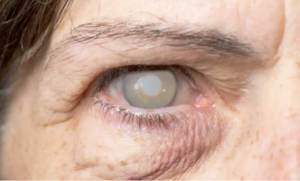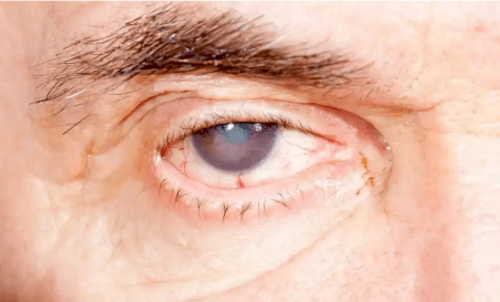9 Symptoms of Cataracts and Natural Treatments


Written and verified by the pedagogue in physical education and nutritionist Elisa Morales Lupayante
A person who’s had cataracts for a while can recognize the symptoms and knows a lot about this ailment. However, the disease can be a mystery to those haven’t experienced it.
According to some people who have this disease, having cataracts is like seeing everything through a foggy window and never being able to clean it. Thus, you can only have a very vague idea of what happens behind the window. Fortunately, cataracts can be treated naturally.
Here, we’ll explain the most common symptoms and natural treatments.
What are cataracts?
Cataracts are the progressive clouding of the human eye’s natural lens. Thus, it translates into blurred vision that slowly gets worse if not treated properly.
Cataracts mostly affect people over 40. They are also the major worldwide cause of progressive blindness, in fact.
Around the age of 40, the human body’s biochemistry begins to change. The proteins that are synthesized by eye cells lose their elasticity and harden.
The proteins clump together in some parts of the ocular lens. This causes whitish lumps that can be seen in people’s eyes. Cataracts cause of loss of accuracy and visibility at certain distances.
However, these whitish lumps don’t appear overnight. Cataracts develop slowly, while the eye tries to adapt to this white blockage.
Different types of cataracts obstruct the light and distort the images that the eye perceives at different angles. Therefore, this type of blindness is different in each person who suffers from it.
See also: Fantastic Exercises for Strengthening Your Eyesight

Types of cataracts
There are three different types of cataracts whose names are directly related to the part of the eye that they affect. At least according to this report from the Mayo Clinic.
Posterior subcapsular cataract
This type is more difficult to identify at a glance. Despite this, the patient feels its effects very quickly as the disease develops.
Patients with diabetes or who take high doses of steroids are more prone to it.
Nuclear sclerotic cataract
As its name suggests, this type of cataract occurs in the nucleus. This is the most common type of cataract among men and women over 70 years.
Cortical cataract
These cataracts are the most visible to the naked eye. They are small opaque and white areas in the eyes. They look like small wedges on the center of the lens.
Symptoms of cataracts
- Cloudy or blurred vision
- Hypersensitivity to light, or discomfort upon contact with bright lights (such as car lights)
- Difficulty seeing in dim or dark spaces
- Filmy vision of the light source, such as lamps and candles
- Yellowing of colors
- Double vision in one eye
- Frequent changes in prescription lenses, meaning the cataracts are quickly degenerating the eyesight
- Difficulty reading
- Some cases lead to myopia, which can improve nearsightedness
However, the symptoms of cataracts are very similar to symptoms of less serious eye problems, such as nearsightedness or astigmatism.
Thus, visit your doctor regularly if you start noticing two or more of these symptoms.
We recommend that you read: 5 Natural Remedies to Stop Macular Degeneration
Natural treatments for the symptoms of cataracts
Experts agree in that the only effective treatment for cataracts is their elimination through eye surgery. For the time being, there are no other alternatives such as eye drops, medications or any other type of therapy to cure cataracts.
However, adopting certain lifestyle habits can prevent their appearance and slow down their development. Although there are no conclusive studies at the moment, many doctors and eye specialists (such as the experts at the Mayo Clinic, among others) strongly recommend this.
Avoid harmful habits
Quitting smoking and reducing alcohol consumption will improve your quality of life. It may be difficult at first, especially due to social pressure.
According to a study conducted by the Vision Research Foundation in India, tobacco consumption is related to the appearance of cataracts. In fact, it even plays a role in the development of other eye diseases.
However, remember that quitting smoking and drinking less will prevent the degeneration of your body. The eyes, like all the other bodily organs, will benefit from healthier habits.
Eat a balanced diet to prevent the symptoms of cataracts
Diet is one of the most important factors in preventing degenerative diseases. A balanced diet helps the body’s balance and effective self-regulation.
Try to integrate a good amount of varied fruits and vegetables. This is because these have an interesting amount of antioxidants that protect the eyes from degeneration. Furthermore, vitamins C and E and omega-3 fatty acids are also helpful.
Protect your eyes from the sun
Although it sounds unlikely, prolonged exposure to the sun’s ultraviolet rays can contribute to the development of cataracts. According to this study from the Universidad de Valladolid in Spain, UV rays can affect proteins and other ocular enzymes. It either degrades or oxidizes them.
Wear sunglasses and wide-brimmed hats to protect you from harmful UV rays.
This is one of the main measures to take into account. According to the American Academy of Ophthalmology, it’s also possible to add anti-UV clear coatings on lenses you regularly use.

Keep your eyes away from screens
Although for the moment no study has established a connection between screen radiation and the appearance of cataracts, this is a measure that helps to protect visual health in general. To do so, stand at least a foot away from devices such as TV sets, cell phones, and computers.
Check your eyes periodically if you have symptoms of cataracts
An eye examination can help detect the problem early and improve its diagnosis and development. Thus, consult your doctor about the frequency of these examinations.
Some risk factors could condition the appearance of cataracts so individual diagnosis is best. Among these factors: family history, age, diabetes, obesity, previous eye treatments or extended unprotected exposure to the sun protection.
Have a medical check-up
It’s important to follow the treatment plan if you have any disease that increases your risk of cataracts.
Proper lifestyle habits can prevent and improve the symptoms of cataracts
Lens opacity (or cataracts) is a prevalent ocular pathology and usually associated with aging. But, the good news is you can slow its onset and development with some easy-to-implement lifestyle habits.
Finally, consult your doctor if you experience vision problems or any of the nine most common symptoms of cataracts. They should be able to prescribe the most appropriate treatment for you and recommend additional guidelines to improve this condition.
All cited sources were thoroughly reviewed by our team to ensure their quality, reliability, currency, and validity. The bibliography of this article was considered reliable and of academic or scientific accuracy.
- Boyd K. ¿Qué son las cataratas? American Academy of Ophthalmology. Septiembre 2021.
- Clinica Barraquer. Cataratas en los ojos. Qué son, síntomas y tratamientos.
- Clinica Mayo. Cataratas. Noviembre 2021.
- Duque Gozalo P. Revisión de los cuidados del ojo para la protección frente a las radiaciones ultravioleta. Universidad de Valladolid. Grado de Enfermería.
- Gladys. RPWRMDBC. Cataratas. Rev Actual Clínica. 2014.
- Kl J-. Cataract in adults. UpToDate. 2018.
- Nash E. Cataracts. InnovAiT . 2013.
- Raju P, George R, et al. Influence of tobacco use on cataract development. British Journal of Ophthalmology. Noviembre 2006. 90 (11): 1374-1377.
- Seddon, J., Fong, D., West, S. K., & Valmadrid, C. T. (1995). Epidemiology of risk factors for age-related cataract. Survey of Ophthalmology. https://doi.org/10.1016/S0039-6257(05)80110-9
This text is provided for informational purposes only and does not replace consultation with a professional. If in doubt, consult your specialist.








